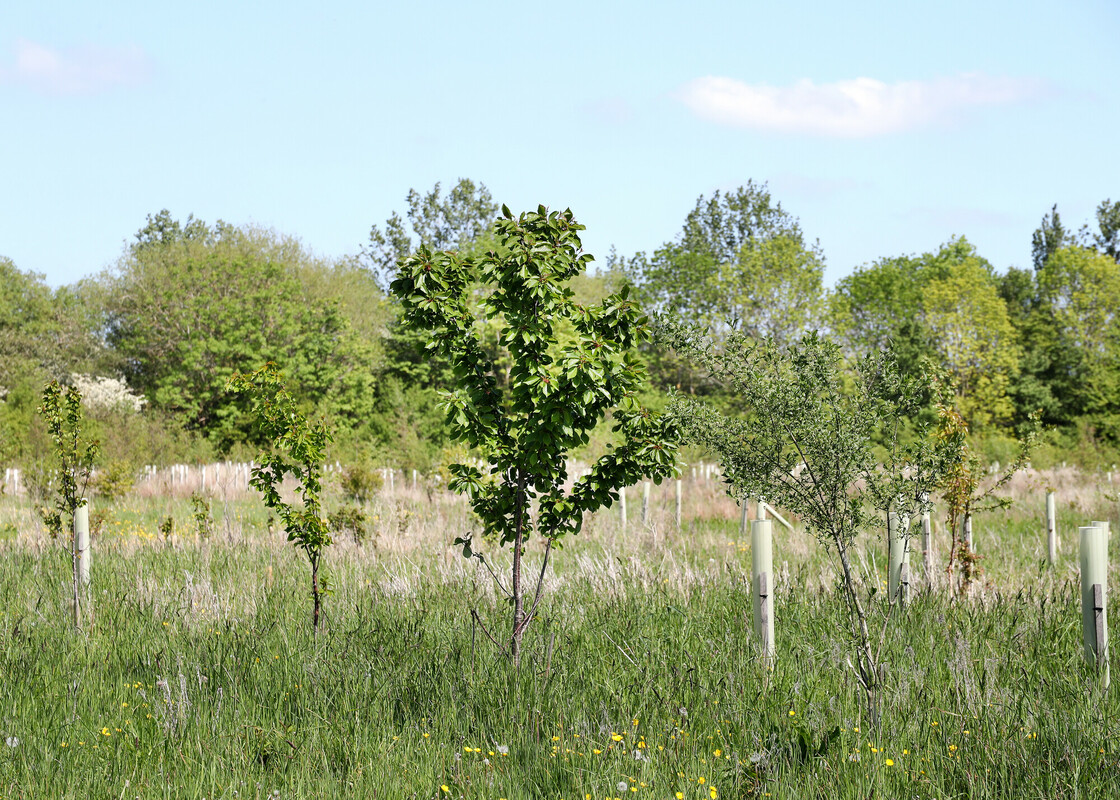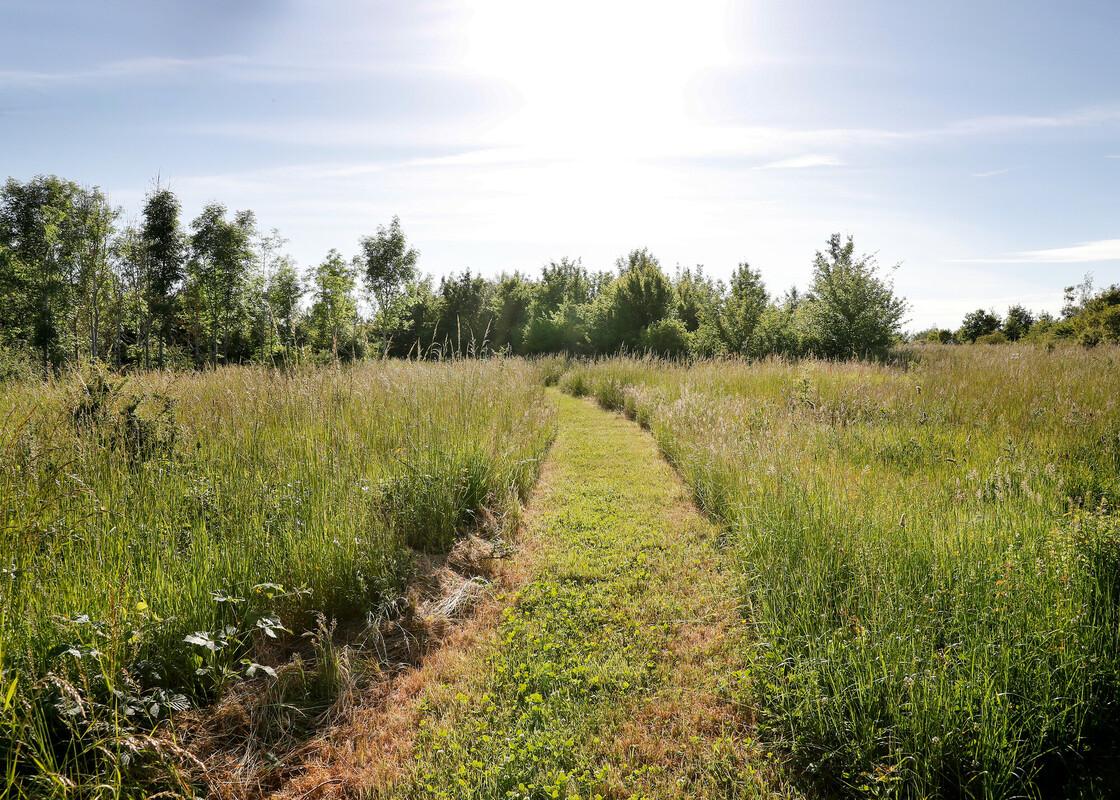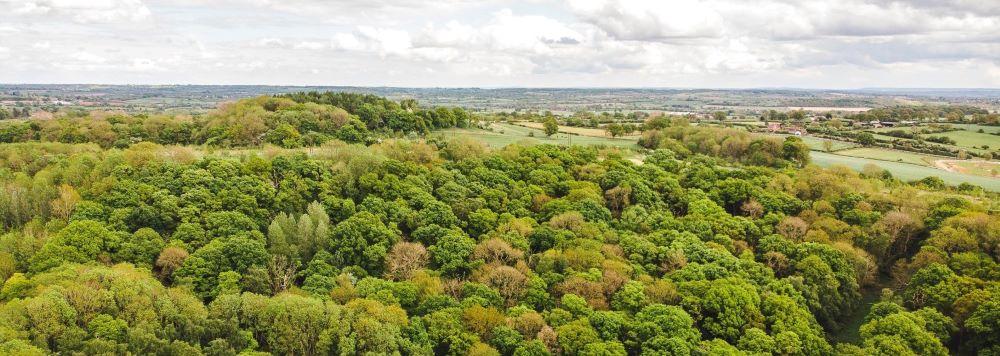
Managing our woodlands
We are creating and conserving a Forest to benefit the environment, wildlife, and people for hundreds of years to come, so nurturing our trees is essential for them to establish and thrive in the long-term.
Why is woodland management important?
The forestry team here at The Heart of England Forest monitors our woodlands for both practical and biodiversity purposes. Monitoring begins when the trees are first planted, and for successful establishment lasts until the trees are growing well and require no more help, but for biodiversity can continue long into the future.

Monitoring for tree establishment
For the successful establishment of young trees, we need to monitor several aspects including survival rates, weed competition, browsing pressure, and success of maintenance interventions. Using this information, we can implement a management programme that gives our trees the best start in life.
When establishing the woodlands we need to allow for browsing from mammals. Here in the Heart of England Forest we have fallow, roe and muntjac deer species, as well as hares and rabbits. All have the potential to nibble young tree stock. At all stages of a woodland’s life, we monitor browsing pressure. Through impact assessments, we can determine the type of deer present, the degree of impact, and although we see browsing as a natural process, we need to work out appropriate measures if browsing is detrimental to the growing forest.
Before planting a new woodland, we need to establish the species of deer present around the site as this will determine the type of tree protection we use. The taller the deer, the bigger the guard needed. Through an assessment of browsing pressure in an area, it is often possible to make an educated guess on the likelihood of browsing of newly planted trees. In this way, we can often reduce our use of guards and fencing.
What work is involved to ensure successful tree establishment?
Tree protection
To protect trees, we have the choice of individual protection with a tree shelter and/or high fencing to exclude deer from the planting area.
Across the Heart of England Forest, individual protective tree shelters have been the most common choice for tree protection, but we have used fencing successfully. One of the difficulties of deer fencing within social forestry, where we are encouraging use of the Forest by walkers, is that sometimes people leave gates open, and once a deer has entered a deer-fenced area, it is hard then to get it out. These deer can then cause more damage, as they are focused in a smaller area.
To ensure successful establishment and prevent unwanted browsing, tree guards need regular maintenance. This typically includes re-straightening after high winds and the replacement of broken tree stakes. Our forestry team undertakes this maintenance in the spring and autumn, often assisted by our hardy volunteers. This activity is completed in years one to three, when good rates of growth are obtained. Once the trees are no longer vulnerable to browsing or other mammal damage, the guards are removed and either reused or recycled. Read more about the use of tree protection in the Forest.

Competitive vegetation
After the initial planting, the first thing we review is the degree of weed competition that surrounds the base of the young trees. When a new woodland is planted, it is particularly important to manage the growth of competing vegetation. This vegetation will compete with the young tree for moisture, nutrients, and space. Without control of competing vegetation, our young trees can often find it difficult to establish and many will perish and need replacing. As much of the ground acquired by the Heart of England Forest is ex-arable, it is often rich in nutrients from previous land management practices and when disturbed this can lead to pioneer plants such as volunteer cereals, broadleaf annuals and bi-annuals emerging.
To ensure our trees get the best start possible, we undertake an inspection in early spring to assess the type of ground cover present in our new plantations, measure its extent, and determine what maintenance intervention, if any, will be required. We have a minimal intervention approach regarding the control of competing vegetation, because many of these competing plants offer habitat and foraging opportunities to a range of species. For example, the tussocky grasses are a great habitat for voles, which in turn support our barn owl populations to grow and thrive across the Forest.
Survival rates
As with all new woodland planting, and for anyone who has tried to establish plants in a garden, a percentage of losses by natural means is to be expected as the young trees adjust from being grown in a nursery to being transplanted into our ground. When we plant our woodlands, we generally overplant, and then we allow up to 10% losses before we start to undertake loss replacement, or in forestry management terms, also called beating up. To establish the numbers required for the beat up, we monitor the survival rate by completing a beat-up assessment. This assessment is completed at the tail end of the summer. Following this we will have an idea of the number of trees to be replaced and understand which species have taken well in which soils on different sites.
Replacing dead trees
Beating up typically occurs for the first three years following initial planting and is undertaken when the young trees are dormant, between the months of November to March.
During the autumn assessment, trees requiring beating up will have their guard marked with a spot of paint, for ease of location at a later stage. Regarding choice of tree species for the beat up, very often the tree species which appear to be doing well following the initial planting will be favoured as replacements. In a good year, we would typically see losses via natural means in the region of 5-10% across the whole new woodland area.

Ongoing woodland monitoring and maintenance
During the spring and summer, the forestry team will routinely visit newly planted woodland to assess the general condition of the trees. These ad hoc inspections can help to record information that will structure works to come in the next few years.
One of the charity's key objectives is to create a haven for visitors to reconnect with nature and immerse themselves in the natural world, so maintaining public access within our woodlands is also very important here at the Heart of England Forest. The monitoring of the 58 miles of permissive footpaths and Public Rights of Way in the Forest is completed by forestry team members who undertake specific checks to ensure the routes remain as risk free as possible. The checks occur weekly during the summer and drop down to monthly during the winter.
During the summer, our forestry team spends over 2,100 hours maintaining public access to ensure that our visitors can enjoy spending time in the woodlands, which includes 350 hours per month inspecting our permissive routes and Public Rights of Way. These footpath checks are used to flag up potential issues, including encroaching vegetation, structural problems with gates/ stiles, trip hazards, and tree safety concerns.
The footpath checks also play a part in structuring the timing of grass cutting on the Public Rights of Way and permissive paths. Our team spends 200 hours per month in the summer on additional maintenance work including mowing, gate repairs and vegetation cutting.

Creating a Forest for now and the future
Effective conservation action is not just about planting as many trees as possible, but about planting sustainably. We put a lot of time and effort into planning and managing our sites to ensure the right trees go in the right places by considering the landscape, the land quality, and the wildlife that inhabits the area.
We estimate that up to 30% of the Forest does not actually have any trees on it, because we are breaking up areas of woodland with wide grassland rides, creating wetland habitats, and planting hedgerows to create a mosaic of habitats, which increases the diversity for both wildlife and people.
Read more about the importance of sustainable tree planting and how we are doing it in the Forest.



